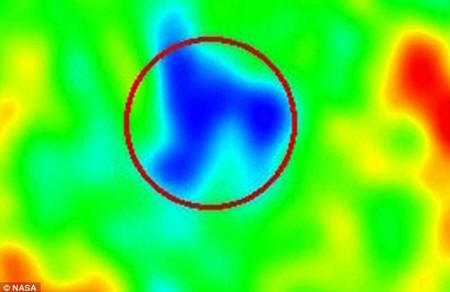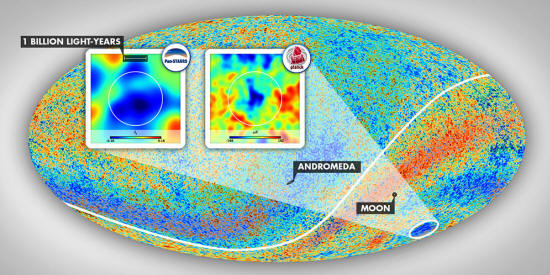|
|
|
Researchers at the University of Hawaii and Manoa have discovered what they are calling,
They are calling it a "supervoid" and it measures 1.8 billion light years across.
This means that it would take 1.8 billion years to travel across this space if you were to travel at the speed of light.
The study (Detection of a Supervoid Aligned with the Cold Spot of the Cosmic Microwave Background) is being published online on April 20 in Monthly Notices of the Royal Astronomical Society by the Oxford University Press.
What’s interesting about this big structure, is that it consists of a great deal of emptiness. It is still populated, but has a significantly lower galaxy count. This part of the universe is unusually cool, researchers were actually looking for this "supervoid" as a means to explain why that area had unusual temperatures.
It’s a region in the sky that’s been dubbed as the "cold spot," and is highly unusual and unexpected given its tremendous size.
The cold spot was discovered 10 years ago and is used by scientists to try and piece together the origins of our universe, as well as explain the big bang - because that theory predicts warmer and cooler spots of various sizes in the universe.
It was discovered using data from Hawaii’s Pan-STARRS1 (PS1) telescope located on Haleakala, Maui, and NASA’s Wide Field Survey Explorer (WISE).
New Discovery Offers Partial Explanation
This new discovery however, still does not explain the mysterious cold spot, but offers a partial explanation.
Space is remarkable, and for the most part, all we can do is develop theories and continue to explain what we have yet to understand completely. Not long ago, scientists suggested that the big bang never even occurred.
Another interesting factor to consider is the weird world of quantum physics, that shows the nature of our reality might not even be physical.
One thing that confuses me is the fact that Szapudi has said this is the largest structure ever discovered, when it doesn’t seem to be a "structure" but just a portion of space with less "stuff."
Regardless, it’s definitely an interesting discovery that adds a piece to the puzzle of what we have yet to comprehend.
-
Largest Known Structure in the Universe Leaves
its Imprint on CMB Radiation -
from
PHYS Website
In 2004, astronomers examining a map of the radiation leftover from the Big Bang (the cosmic microwave background, or CMB) discovered the Cold Spot, a larger-than-expected unusually cold area of the sky.
The physics surrounding the
Big
Bang 'theory' predicts
warmer and cooler spots of various sizes in the infant universe, but
a spot this large and this cold was unexpected.
If the Cold Spot originated from the Big Bang itself, it could be a rare sign of exotic physics that the standard cosmology (basically, the Big Bang theory and related physics) does not explain.
If, however, it is caused by a
foreground structure between us and the CMB, it would be a sign that
there is an extremely rare large-scale structure in the mass
distribution of the universe.
This void was found by combining
observations taken by PS1 at optical wavelengths with observations
taken by WISE at infrared wavelengths to estimate the distance to
and position of each galaxy in that part of the sky.
Paradoxically, identifying nearby large structures is harder than finding distant ones, since we must map larger portions of the sky to see the closer structures. The large three-dimensional sky maps created from PS1 and WISE by Dr. András Kovács (Eötvös Loránd University, Budapest, Hungary) were thus essential for this study.
The supervoid is only about 3 billion
light-years away from us, a relatively short distance in the cosmic
scheme of things.
By the time the light descends the hill, the hill has gotten flatter than when the light entered, so the light cannot pick up all the energy it lost upon entering the void.
The light exits the void with less
energy, and therefore at a longer wavelength, which corresponds to a
colder temperature.
While the existence of the supervoid and its expected effect on the CMB do not fully explain the Cold Spot, it is very unlikely that the supervoid and the Cold Spot at the same location are a coincidence.
The team will continue its work using
improved data from PS1 and from the
Dark Energy Survey being conducted
with a telescope in Chile to study the Cold Spot and supervoid, as
well as another large void located near the constellation Draco.
In addition to Szapudi and Kovács,
researchers who contributed to this study include UH Manoa alumnus
Benjamin Granett (now at the National Institute for
Astrophysics, Italy), Zsolt Frei (Eötvös Loránd), and
Joseph Silk (Johns Hopkins).
|



